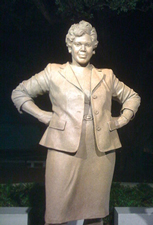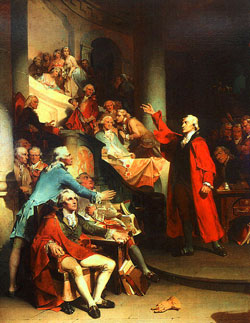Other speakers aside from President Obama have used allusions in their speeches. As a rhetorical device, allusion can be used to generate interest, highlight ideas, improve the flow of words, and persuade an audience. As tools of persuasion, allusions offer an audience new ways to look at an idea or deepen understanding about a topic. When you recognize what an allusion refers to, you can experience the full impact of a speaker’s words.

Source: Barbara Jordan Memorial, Robert Wyatt, Wikimedia
Barbara Jordan (1936-1996) was an American politician whose rise to leadership began during the civil rights movement. She was the first African-American woman elected to the Texas Senate as well as the first from the South to be elected to the United States House of Representatives.
Jordan was the definition of an eloquent orator (not literally, but metaphorically). Her rhetoric was decidedly traditional and shaped by her legal and legislative work. She sprinkled her speeches with allusions. Her keynote address to the Democratic Party in 1976 contains some good examples.
Read the excerpt below and find the allusion. When you think you have found it, click on each word that is part of the allusion. If you choose correctly, the text will highlight. Don’t be fooled! The allusion is more than one word!
Click to listen to Barbara Jordan’s speech. Listen to at least the first part of the speech through 1:34, or you may want to listen to her entire speech.
I, Barbara Jordan, am a keynote speaker.
A lot of years passed since 1832, and during that time it would have been most unusual for any national political party to ask a Barbara Jordan to deliver a keynote address. But tonight, here I am. And I feel . . . that notwithstanding the past that my presence here is one additional bit of evidence that the American Dream need not forever be deferred.

Sample Response:
She is alluding to Langston Hughes’ poem “Harlem,” which begins with the question “what happens to a dream deferred?” U.S. Representative Jordan is making the point that her dream to speak to a national audience has not been forever “deferred” or delayed as Langston Hughes suggests when he asks his question. Ms. Jordan says that in 1832 there is no way an African-American woman could have delivered a speech at a national convention; yet here she is in 1976 realizing her dream.
Her statements might also allude to Dr. Martin Luther King, Jr.’s famous “I Have a Dream” speech. In the speech, Dr. King says that all Americans should be afforded the same opportunities, regardless of who they are. Knowing about the reference to Langston Hughes’ poem and about Dr. King’s famous speech connects you to Barbara Jordan’s personal story and enables you to share both her pride and humility in this accomplishment.

Source: Patrick Henry Rothermel, Peter Rothermel, Wikimedia
In the next speech example, Founding Father Patrick Henry addresses the Virginia assembly who had gathered that evening in 1775 to hear his response to recent British encroachments on the Colonies.
Read the excerpt from that famous speech below and find the allusions. When you think you have found them, click on the text. If you choose correctly, the text will highlight. Hint: This time the allusions are Biblical.
“I have but one lamp by which my feet are guided, and that is the lamp of experience. I know of no way of judging of the future but by the past. And judging by the past, I wish to know what there has been in the conduct of the British ministry for the last ten years to justify those hopes with which gentlemen have been pleased to solace themselves and the House. Is it that insidious smile with which our petition has been lately received?
Trust it not, sir; it will prove a snare to your feet. Suffer not yourselves to be betrayed with a kiss. Ask yourselves how this gracious reception of our petition comports with those warlike preparations which cover our waters and darken our land.”

Sample Response:
“One lamp by which my feet are guided” is the first of two Biblical allusions that Patrick Henry uses in this passage. This first allusion refers to a passage in the Book of Psalms, which states “Thy word is a lamp unto my feet and a light unto my path.” In this passage, the Hebrew King David is exalting Israel’s God as the true path for achieving righteousness and clarity.
Henry uses this allusion to emphasize that the colonies must follow the one true path of the righteous in order to achieve victory.
The second allusion Henry makes refers to the disciple Judas Iscariot’s infamous kiss in the New Testament. Judas betrayed Jesus by kissing him on the cheek when Roman soldiers arrived to arrest him. Judas had prearranged the signal so that the Romans would know which man to arrest.
Henry uses the second allusion to emphasize that any favors that that the British promise are only a kiss that will invite more trouble via British infringements on colonial rights and liberty.